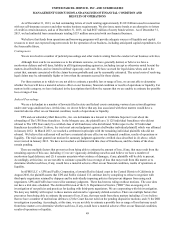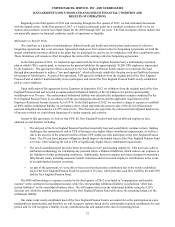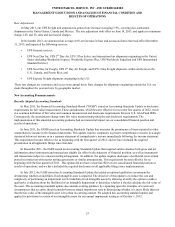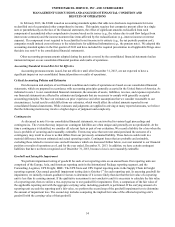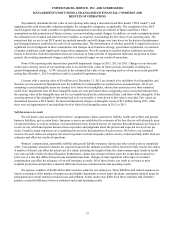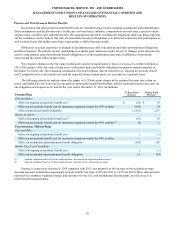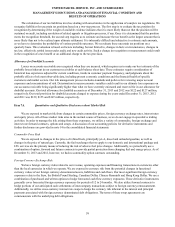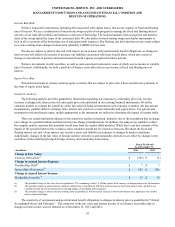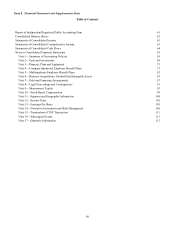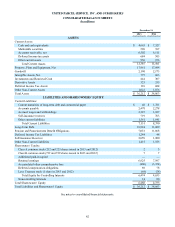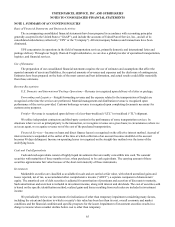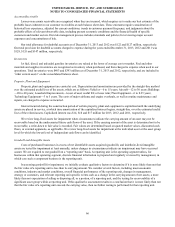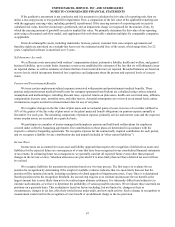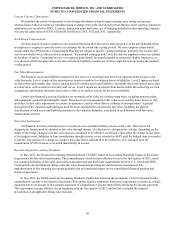UPS 2013 Annual Report Download - page 71
Download and view the complete annual report
Please find page 71 of the 2013 UPS annual report below. You can navigate through the pages in the report by either clicking on the pages listed below, or by using the keyword search tool below to find specific information within the annual report.
UNITED PARCEL SERVICE, INC. AND SUBSIDIARIES
MANAGEMENT'S DISCUSSION AND ANALYSIS OF FINANCIAL CONDITION AND
RESULTS OF OPERATIONS
59
Interest Rate Risk
We have issued debt instruments, including debt associated with capital leases, that accrue expense at fixed and floating
rates of interest. We use a combination of interest rate swaps as part of our program to manage the fixed and floating interest
rate mix of our total debt portfolio and related overall cost of borrowing. The notional amount, interest payment and maturity
dates of the swaps match the terms of the associated debt. We also utilize forward starting swaps and similar instruments to
lock in all or a portion of the borrowing cost of anticipated debt issuances. Our floating rate debt and interest rate swaps subject
us to risk resulting from changes in short-term (primarily LIBOR) interest rates.
We also are subject to interest rate risk with respect to our pension and postretirement benefit obligations, as changes in
interest rates will effectively increase or decrease our liabilities associated with these benefit plans, which also results in
changes to the amount of pension and postretirement benefit expense recognized in future periods.
We have investments in debt securities, as well as cash-equivalent instruments, some of which accrue income at variable
rates of interest. Additionally, we hold a portfolio of finance receivables that accrue income at fixed and floating rates of
interest.
Equity Price Risk
We hold investments in various common equity securities that are subject to price risk. These securities are primarily in
the form of equity index funds.
Sensitivity Analysis
The following analysis provides quantitative information regarding our exposure to commodity price risk, foreign
currency exchange risk, interest rate risk and equity price risk embedded in our existing financial instruments. We utilize
valuation models to evaluate the sensitivity of the fair value of financial instruments with exposure to market risk that assume
instantaneous, parallel shifts in exchange rates, interest rate yield curves and commodity and equity prices. For options and
instruments with non-linear returns, models appropriate to the instrument are utilized to determine the impact of market shifts.
There are certain limitations inherent in the sensitivity analyses presented, primarily due to the assumption that exchange
rates change in a parallel fashion and that interest rates change instantaneously. In addition, the analyses are unable to reflect
the complex market reactions that normally would arise from the market shifts modeled. While this is our best estimate of the
impact of the specified interest rate scenarios, these estimates should not be viewed as forecasts. We adjust the fixed and
floating interest rate mix of our interest rate sensitive assets and liabilities in response to changes in market conditions.
Additionally, changes in the fair value of foreign currency derivatives and commodity derivatives are offset by changes in the
cash flows of the underlying hedged foreign currency and commodity transactions.
Shock-Test Result
As of December 31,
(in millions) 2013 2012
Change in Fair Value:
Currency Derivatives(1) $(291) $ (1)
Change in Annual Interest Expense:
Variable Rate Debt(2) $ 7 $ 7
Interest Rate Derivatives(2) $ 101 $ 106
Change in Annual Interest Income:
Marketable Securities(3) $ 15 $ 10
(1) The potential change in fair value from a hypothetical 10% weakening of the U.S. Dollar against local currency exchange rates across all maturities.
(2) The potential change in annual interest expense resulting from a hypothetical 100 basis point increase in short-term interest rates, applied to our
variable rate debt and swap instruments (excluding hedges of anticipated debt issuances).
(3) The potential change in interest income resulting from a hypothetical 100 basis point increase in short-term interest rates, applied to our variable
rate investment holdings.
The sensitivity of our pension and postretirement benefit obligations to changes in interest rates is quantified in “Critical
Accounting Policies and Estimates”. The sensitivity in the fair value and interest income of our finance receivables due to
changes in interest rates was not material as of December 31, 2013 and 2012.


